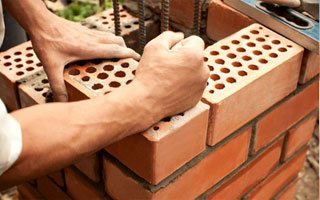Schedule a Chimney Sweep Today for a Clean and Safe Fireplace
Schedule a Chimney Sweep Today for a Clean and Safe Fireplace
Blog Article
Unlocking the Tricks of Sustainable Stonework Construction Practices for Eco-Friendly Structures
Amongst the myriad strategies to green building, sustainable stonework construction stands out as a reliable and long lasting method that holds a riches of untapped potential. From the option of materials to ingenious construction methods, the secrets to achieving sustainability within masonry construction are multifaceted and intriguing.
Benefits of Sustainable Masonry Building
Accepting lasting stonework building techniques not just minimizes ecological effect however also provides long-term economic benefits to building contractors and areas. By making use of materials like recycled bricks, blocks, and rocks, building contractors can significantly lower the carbon impact of their jobs while promoting source performance. Furthermore, lasting masonry construction techniques, such as correct insulation and thermal mass homes, can enhance energy efficiency within structures, causing decreased operational prices with time.
Additionally, the longevity and durability of masonry frameworks add to lasting economic advantages. Structures constructed making use of sustainable stonework methods typically require less upkeep and repair service, equating to set you back financial savings for home builders and homeowner. The durability of masonry products likewise makes sure that structures continue to be steady and secure, lowering the requirement for constant restorations or replacements.
Eco-Friendly Masonry Products
Utilizing green masonry products is a pivotal action towards boosting the sustainability of building techniques and minimizing ecological influence while making the most of long-term economic advantages. Sustainable stonework materials are sourced, created, and made use of in a manner that lowers general ecological influence. Materials such as recycled blocks, redeemed rock, and sustainable cinder block are coming to be increasingly prominent selections for eco-conscious contractors. Recycled blocks, as an example, not only divert waste from garbage dumps however additionally require less energy to generate contrasted to new bricks. Redeemed stone provides an one-of-a-kind visual appeal while decreasing the requirement for brand-new quarrying. Lasting concrete obstructs include recycled aggregates and may include enhanced insulation residential or commercial properties, adding to energy effectiveness in buildings.
Additionally, natural products like adobe, rammed planet, and straw bales provide excellent thermal mass properties, lowering the requirement for heating and cooling down energy. These products are usually locally available, advertising regional economies and lowering transportation-related carbon discharges. By selecting environmentally friendly masonry materials, building projects can dramatically minimize their environmental impact and contribute to the development of healthier, a lot more sustainable constructed environments.
Energy-Efficient Stonework Strategies
Power performance plays a vital role in improving the sustainability of stonework building methods. One vital energy-efficient masonry method is the usage of thermal mass, which involves including dense products like concrete or brick into the building's framework to soak up and store warm.

Technologies in Sustainable Stonework
Recent improvements in sustainable masonry techniques have actually brought around innovative methods that are reshaping the construction sector. One such advancement is the advancement of self-healing concrete, which makes use of bacteria installed within the concrete to heal splits autonomously. This advancement not just minimizes upkeep expenses yet likewise boosts the longevity of masonry frameworks, contributing to their sustainability.
One more notable advancement is making use of recycled accumulations in stonework construction - masonry contractor. By including materials such as crushed ceramic waste or recycled glass right into concrete mixes, building contractors can decrease the ecological impact of building tasks while maintaining structural stability. This practice not only draws away waste from landfills however additionally conserves all-natural sources, making it a crucial innovation in sustainable stonework construction
Additionally, the combination of electronic layout tools, such as Building Information Modeling (BIM), is transforming the method stonework frameworks are intended and constructed. BIM enables more accurate computations, minimized product wastefulness, and improved energy efficiency, eventually causing even more lasting building techniques. These developments collectively represent an encouraging future for lasting stonework building and construction in the era of green structures.
Future Trends in Masonry Sustainability
With the innovative strides made in sustainable stonework techniques, the future fads in stonework sustainability are positioned to more revolutionize the construction industry. One of the key trends shaping the future of masonry sustainability is the enhanced combination of innovation. Improvements such as Building Information Modeling (BIM) and virtual fact simulations are being made use of to maximize stonework building processes, leading to reduced product waste and enhanced power effectiveness in buildings.
Furthermore, the growth of unique sustainable materials is readied to play a substantial function in improving the eco-friendliness of masonry construction. masonry contractor. Technologies like self-healing concrete, recycled accumulations, and bio-based binders are obtaining grip for their ability to decrease ecological impact while keeping structural integrity

Conclusion
In final thought, lasting stonework construction practices provide many advantages for environmentally friendly structures. By making use of eco-friendly materials and energy-efficient techniques, masonry can add to a more sustainable built environment. Advancements in sustainable masonry are constantly being established to better boost the ecological efficiency of structures. Looking in the direction of the future, the fad of stonework sustainability is expected to grow, bring about even more ecologically pleasant and energy-efficient building and construction techniques in the years ahead.
Report this page